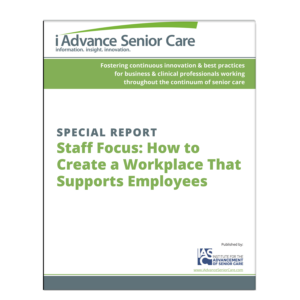Staffing fireworks!
Staffing issues have hit the headlines in all their “up-and-down” glory over the past few weeks. I can’t recall a similar period when staffing so dominated the news. Starting with a June 11 U.S. Supreme Court decision declaring home health workers ineligible for federal minimum wage and overtime protections, the airwaves and the “Web waves” have been jumping with good news and bad news regarding long-term care staff. In rough order:
The American Geriatrics Society releases a report indicating that 1 million more professional caregivers will be required over the next 10 years, despite a dwindling of the primary market resource for these caregivers (women in their mid-20s through mid-50s) to a virtually no-growth situation.
A My InnerView satisfaction study of the national nursing home workforce discloses that nursing and nursing assistant staff are more satisfied with and longer-lasting at their jobs than is generally believed (not to say there isn’t significant room for improvement).
The U.S. Senate at least temporarily derails organized labor–favored legislation that would have expedited union organizing efforts in various fields, including healthcare.
The Service Employees International Union launches a healthcare-oriented campaign shortly after starting an assisted living–focused Web site seeking resident/employee “stories.”
Nursing Homes/Long Term Care Management might be creating its own bit of news with an article in this issue by widely respected labor law attorney John E. Lyncheski noting that the U.S. Department of Labor has all but declared war on long-term care providers in its Fair Labor Standards Act enforcement.
In short, lots of ups, downs, and heavy-duty pressure—an uncomfortably volatile situation for a field that has enough problems already facing the forthcoming “Age Wave” boom in demand for services. It’s obviously time for all providers to focus on staffing issues with unparalleled intensity. They will have to come up with good answers to tough questions like: What will it take to attract and keep dedicated workers? What can we afford in financial and educational support? How can we be successful employers without breaking the bank?
Much of this will test owner/operators’ personal mettle. While it’s a truism that most people are decent or want to be decent, the employer/employee relationship introduces power into the equation, and with power comes the temptation to control. Low-wage staff can be written off as basically interchangeable parts (as the offspring of a working-class family, I’ve experienced this attitude firsthand). Managers can lose sight of the fact that the most potent anti-union tactic is decent behavior. May this message ring true no matter how the winds blow for long-term care staffing in the future.
RICHARD L. PECK, EDITOR-IN-CHIEF
To send your comments on this editorial to the author and editors, e-mail peck0707@nursinghomesmagazine.com.

Richard L. Peck was editor in chief of I Advance Senior Care / Long-Term Living for 18 years. For eight years previous to that, he served as editor of the clinical magazine Geriatrics. He has written extensively on developments in the field of senior care and housing.
Related Articles
Topics: Articles , Staffing











